Darśan - Tiruvallikkēṇi Srī Pārthasārathi Perumāḷ
|
சென்னை நகரின் சீர்மிகு கோயில்கள்!
Chennai city’s famous temples. |
திருவல்லிக்கேணி ஸ்ரீபார்த்தசாரதி பெருமாள்
பி.சுவாமிநாதன்
P. Swaminathan
The Mahābhārata war lasted for 18 days. Bhagavan served as the
charioteer for the Archer extraordinaire Arjuna to whom Bhagavan Kaṇṇapirāṉ
taught Bhagavadgita, known all over the world. The advice in the Gita is
numerous for an individual relieved of a battle in his mind and
attaining mental clarity. It talks about path of virtue in life and
living with many examples. It happened at the end of Dwāpara
Yuga, about 5000 years ago.
Bhagavan presented Gita in the battle field. He appears as a member of
the family in the Tiruvallikkēṇi Temple and is waiting to lead us in the
path of Gita. Paramātmā sports a twisted mustache and is the fixed deity
as Sri Venkata Krishnan and the processional deity as Pārthasārathy
Perumāḷ. The temple is named after the processional deity. He appears in
a family configuration: Consort Śrī Rukmaṇi Pirāttiyār, elder brother
Balarāma, younger brother Sātyaki, son Pradyumna, and grandson
Aniruddha. There are very few temples with such a family constellation.
Parantāmaṉ with his family invites the Kaliyga devotees with grace. It
is a special privilege to receive Darśan, according to Vaishnavas.
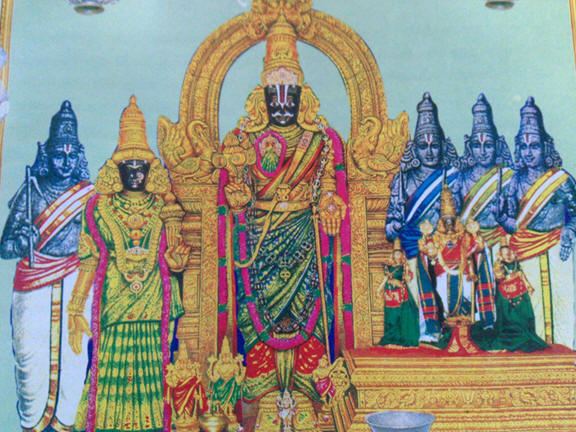
Triplicane Parthasarathy temple is the only temple where three
generations are present in the Sanctum sanctorum. Here Lord Krishna
gives darshan along with Balaram (elder brother), Rukmini(consort),
Pradhyumna (son), and Aniruddha (grandson). Nowhere can you see such a
spectacle. This temple is one of the 108 Divya Desam temples of Vishnu. Triplicane is in the heart of Chennai city.
http://epuja.co.in/unique_facts.php
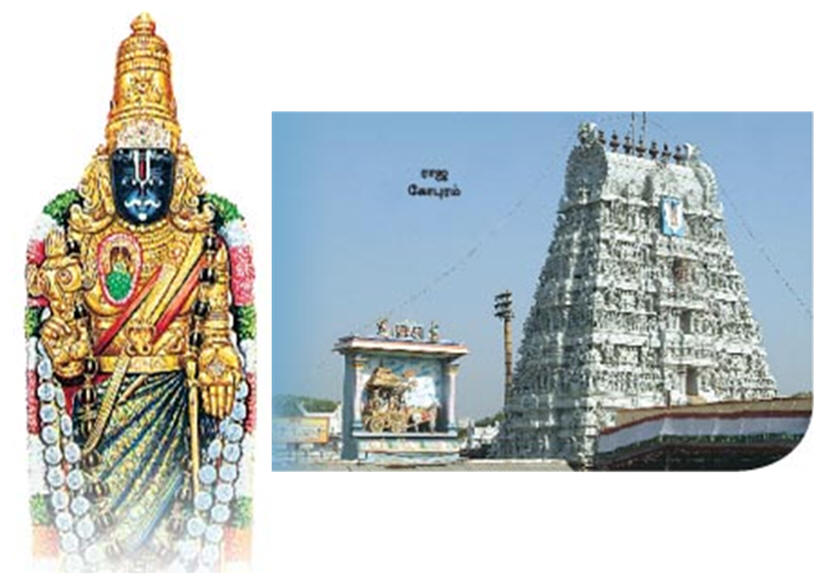
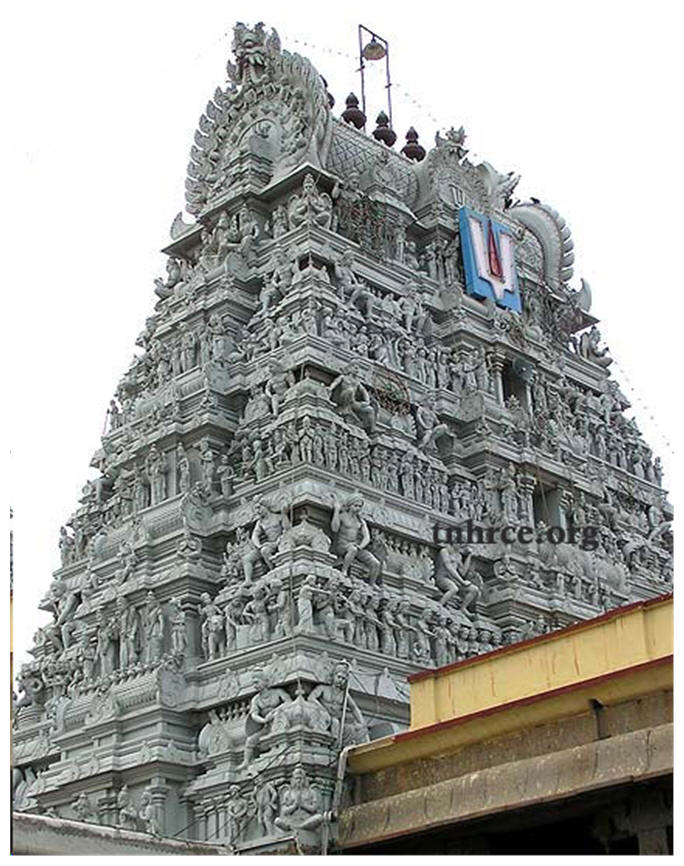

This temple is one among the 108 Divine Temple Sites. The temple
received
Maṅkaḷācācaṉam
(laudatory poetical benediction) from three Azvars: Tirumangaiyāzvār,
Peyāzvār,
and Tirumazisaiyāzvār.
This is how this temple takes the pride of place.
In olden days, Myilai was famous for Saivam and Tiruvallikeni of Chennai
for Vaishnavam. In 1952, the income for Sri Parthasarathi Perumal temple
was about Rs. 81,210 and expenses were Rs. 66,216 according to one note.
Venkatavan-fame Tiruppathi and Venkatakrishnan-fame Tiruvallikeni were
in constant contact with each other for many centuries, an astonishing
news.
Many centuries ago, the devotees returning south to Tamil Nadu after
obtaining Darsan of Venkatava of Tirumalai-Tiruppathi came to
Tiruvallikkeni Temple site for rest and relaxation. Later they bathed in
the ocean and offered heartfelt worship to Sri Parthasarathy Perumal
chanting ‘Govinda-Govinda.’ They then dined on free food in the
canteens.
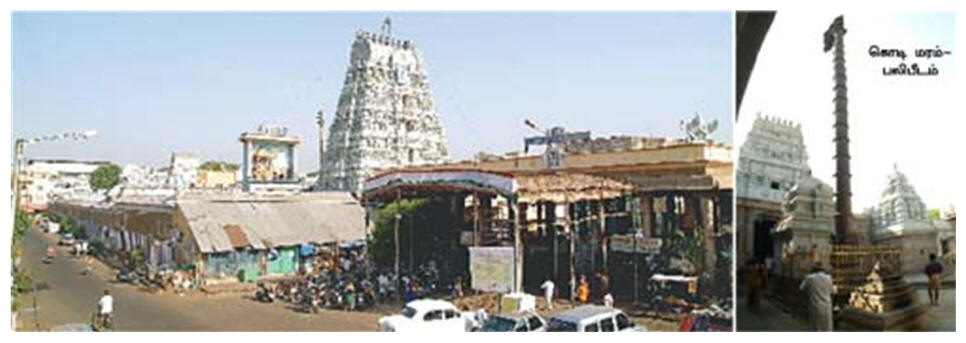
Tirumazisai Azvār
the disciple of Peyāzvār
stayed here for many years in a yoga state. Achāryās
Sri Bāshyakkārar,
Ālavandār,
and Vedāntachāriyar,
musical greats like Sri Thiyāgarājar,
Muthusāmi
Dhīshithar…
visited the temple. Built by Pallava kings and holy services maintained
by Chōza-Pāndiya
kings, the temple thrived.
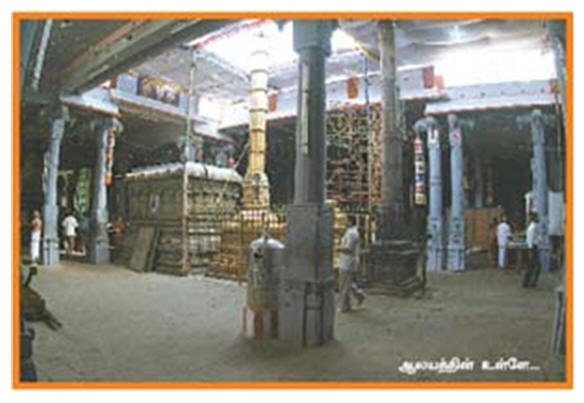
For the residence of Sri Parthasarathy Perumal, this temple is immaculate. This is a high-tech temple and an eye-candy. The temple is air-conditioned in all four shrines including the main shrine of the fixed deity. In all of Tamil Nadu, this is the first temple to install in the Mūlavar Shrine the Cell Phone Breaker (in 2007), which was paid for by a devotee at a cost of Rs. 25,000.
Since there were water-lilies in the temple pond, this area in the past
was called Tiru Allikēṇi
(Sacred Lily pond). Puranas call this temple site Bhirunthāraṇya
Kṣetra
(Sacred Basil forest). In front of the temple, there is holy lake
Kairaviṇi.
The tradition is that waters of five holy ponds (Indira, Soma,
Mīṉa, Agṉi, Viṣṇu) are contained in the Kairaviṇi pond. This holy tank
is holier than Ganga according to
Ṣthala Purāṇa. The Temple Tank is maintained well by the students and
Public Weal Society. This
temple’s Ṣthala Virutsam (Temple Tree) is Banyan tree, standing in the
front yard of the temple.
(துவசாரோகணம் tuvacārōkaṇam
, n. < dhvajaārōhaṇa. 1. Ceremonial hoisting of flag in a
temple at the commencement of the annual festival) (மண்டபம்¹
maṇṭapam , n. < maṇḍapa. 1. Pavilion in a temple or other place used
during festivals for the reception of idols when they are carried in
procession, generally a square or rectangular hall with a flat roof)
பலிபீடம்
(sacrificial Pedestal).
Rajagopuram has five levels; seven Kalaṣas;
left wall depicts Gītāchāryaṉ
in an ambrosial painting. As you enter, the office is on the left side.
Further down, there are Duvajārōkaṇa
Maṇḍapam
(Flagpole Pavilion with hoisted flag), Balipīdam
(sacrificial alter or pedestal). Flagpole, Garudāzvār
shrine. On the right side, is the Kalyāṇa
Maṇḍapam
(wedding Hall—Hall for Temple functions). This is where the festivals
take place. Near it are the Yāga Sālai,
Mirror Room. South of Mirror Room is the Heaven Gate.
Straight from the Garuda Shrine is the Thoṇḍaraḍippoḍi
(Thoṇḍar-aḍi-p-poḍi)Azvār
gateway. Going through the gateway we see Sri Parthasarathy Perumal
appearing majestic and tranquil with his family. It is the custom to
take a walk on the circumambulatory path, offer worship to the deities
in the shrines along the way and then worship the fixed deity. Let us go
on the pathway.
On the path, we see the kitchen and the well, the water from which is used for daily services. On the right side, we see the Friday Hall
supported by four columns. Here Vedavalli Thāyār’s
Swing service takes place. Past this, going south is her own separate
shrine of Vedavalli Thāyār.
The processional idol of Vedavalli Thāyār-the
Beauty in all body parts- shines with fragrant flowers in the front.
The Darśan of the fixed deity comes later.
Sriranganāthar-Mannāthar
offers his grace in the subsidiary shrine. His consort is Sri Vedavalli
having her own shrine. A
special festival is conducted on a grand scale. How did Vedavalli get
importance? Let us see what Purana says.
Bhirunthāraṇyam (Tiruvallikkēṇi) was where Ṛṣis Bhṛgu, Atri, Marīchi,
Mārkkaṇḍēyar, Saptharōmā, Jāpāli…performed severe penance. There was a
kerfuffle between Perumāḷ and Lakshmi in the Milk Ocean. Pirātti in a
fit of anger leaves alone. The forthcoming drama is known to Nārāyaṇa.
Lakshmi appears as a beautiful girl under the Sandalwood tree where the
Ṛṣis
perform Tapas or austerity. Bhṛgu
Mahaṛṣi
came to the tree by happenstance and seeing the girl, prattled. He
picked up the child and gave her to his wife.
She was named Vēdavalli.
They brought her up with love and kindness, as if she was their own.
Afflicted by sorrow from separation from Tirumakaḷ,
and thinking, ‘separation no more,’ Perumal went from the Milk Ocean to Bhūlōkam
(World) and entered Bhirunthāraṇyam,
where he saw a teenage girl Vēdavalli
serving the great men. He showed his true form to the Bhṛgu
Muṉi
and expressed his desire to marry Vēdavalli.
Seeing Manāḷaṉ,
Vēdavalli
was ecstatic and consented to the wedding.
Bhṛgu
Muni supplicated to Perumāḷ
to remain there in residence after the wedding. Perumāḷ
consented to the proposal and demanded that wedding took place
immediately.
On the wedding platform, Vēdavalli side glanced the groom with modesty
and called him Maṉṉāthaṉ thinking, “He is my Thalaivaṉ (Lord).”
That became Araṅgaṉ (The Lord of
the stage), the holy name of Viṣṇu. The wedding takes place in the month
of Māci, the day of Suddha Sukla Pakṣa Duvādasi (The day of bright moon
on the 12th day). Sthala Purāṇa states Mahaṛṣi himself was in
the forefront for this event. The wedding ceremony proceeds on a grand
scale with fire sacrifice, stepping on the flat grinding stone, and
conducting Sapthapathi (chanting Mantras).
சப்தபதி capta-pati
, n. < sapta-padī. A marriage rite in which the bridegroom
pronounces certain mantras and leads the bride seven steps round the
sacred fire
திமிலோகப்படு-தல்
timilōka-p-paṭu-, v.
intr. <
துமிலம் +.
To be performed with great eclat (showy
or elaborate display)
When you perform circumambulation, Theḷḷiyasingar/Sri
Narasimha Swami’s Mahā
Maṇḍpam
comes into view. On the left is Sri Tirumizisai
Āzvār
shrine for worship. What a wonderful layout. Separate Temple layout with
its own entrance. Duvajārōkaṇa
Maṇḍapam, Garuḍāzvār shrine, flagpole, Balipīdam, Dvārapālakars, Kalyāṇa
Maṇḍapam
are the features here. The special feature is that the fixed deity goes
out through this special gate and reenters back in.
For Sri Narasimhar, in the month of
Āṉi 10-day
Brahmōṛsavam
takes place as it happens for Pārthasārathy.
For Atri and Jāpāli
Munis, Theḷḷiyasingar
gave true-to-life Darśan. Let us look at it briefly. Brahmāṇḍa
Purana talks about Avatāra
of Emperumāṉ
in the form of Theḷḷiyasingar.
Atri Muni performed severe penance in Bhirunthāraṇyam
asking for birthless Varam in expectation of Mukti. Atri came to know of
the wonderful news that Emperumāṉ
in the guise of Māmuni
Vikatar would confer him grace and Darśan. The news spread far and wide.
The blessed day of Darśan came to the fore.
The Devas standing as if in a circle of sprinkled flowers…
Āḍisēṣaṉ,
Garudāzvār, Sēṉai
Muḍaliār, Saṉakāthi Muṉis…performed services…Perumāḷ gave Darśan to Ātri
Muni from the aerial car in the form of Narasiṅgar as given to
Prahalāthaṉ.
Ātri
fell prostrate and submissive addressed Perumāḷ,
“Maṇivaṇṇā…
please confer on my disciples and me Mukti (liberation).” Perumāḷ
obliged him and his disciples. Later on, consenting to the request of
Atri, he established himself there with grace as Theḷḷiyasingar. He is
the greatest boon-giver and calls the disciple with his left-hand
finger, “Come near” and gives protection from fear.
Here Narasimhar is in Yoga stance, the bells on the shrine’s doors do
not have tongues (clappers). The bell sounds disturb his Yoga. Sri
Āṇḍāḷ’s
shrine is the north of his Maṇḍapam.
There are individual shrines for
Āḷavanthār,
Kūrathāzvār,
Muthaliāṇḍāṉ,
Maṇavāḷa
Māmunikaḷ,
Srībhāṣyakkārar, Veḍānthāchāriyar, Thirukkacchi Nambikaḷ…
We are now near Mūlavar
Pārthasārathy
Shrine. On the right are the shrines of SrīRanganāthar (Maṉṉāthar),
Chakravarthy’s holy son, Ciṛiya
Thiruvaḍi,
Āzvārs…
In
Āḍisēṣaṉ
Paṭalam
(section)
Srī Maṉṉāthar in his Yoga Nidra (Deep Sleep with Awareness) appears
facing direction. There are several festival days during the year for
Vēdavalli Thāyār and Srī Maṉṉāthar.
Yogic Sleep or Yoga Nidra is unconscious delta-wave deep Sleep with
complete awareness (sounds paradoxical). Yogis during Yogic sleep
demonstrate delta waves, snore in deep sleep and yet can tell what went
on around them during deep sleep confirmed by Delta waves.
Ramapiran stands looking south with Sita, Lakshmana, Bharata,
Satrukkana, Hanumān…
Rama gave vision of himself to Madhumān
Mahaṛṣi.
Srī
Venkatakrishnar
shrine. It is an impressive shrine immersing the devotee in the
rapturous devotion. Great king Sumathirājan
is a serious Perumāḷ
devotee. He upon Darśan of Tirumalai Vēṅkatavaṉ
supplicated to him, “O Perumāḷ
I want to see and enrapture in your role as the charioteer Srī
Kaṇṇaṉ.”
Bhagavān said, “Go to Bhirunthāraṇya
Kṣētra.
There I will present Darśan of myself to you in the guise of Kaṇṇaṉ.
Accordingly, Sumathirājaṉ
performed Tapas (austerity) in Bhirunthāraṇyam
and obtained Darśan of Srī
Vēṅkatakrishnar,
which we celebrate today.
Darśan by Vēṅkatavaṉ
in the guise of Krishna is the reason he is called Vēṅkatakrishnar!
Here is where Vyāsa
Muṉi
established with glory the temple according to Sthala Purāṇa.
The herein found Mūlavar’s
holy constitution is the Sorūpam
(self-same form) of Bhagavan in Gītā.
Holding conch on the right hand, showing Varatha Hastha (upheld open
palm pose for giving boon) on the left hand, and standing in his holy
guise, Srī
Vēṅkatakrishnar
serves humanity. Rukmaṇi
Pirāttiyār
stands on Perumāḷ’s
right side with a beauteous face. Balarāma
stands on the right side facing north holding a plough on one hand and
presenting Varatha Hasta on the opposite hand.
With Sātyaki
the younger brother on Perumāḷ’s
left side
with Pradyumṉa
(son) Aniruththaṉ
(grandson)…facing south, Perumāḷ’s
family constellation
confers grace. The Arucchakar (the priests) narrate the names and
relationships among members of the Mālavaṉ’s
family lineage, waving ceremonial lights. The sight is a pinnacle of
beauty and wonder.
In front of the shrine are present the processional deity Srī
Pārthasārathy
Perumāḷ,
Srī
Dēvi,
and Bhū
Dēvi.
Pārthasārathy’s
face shows battle scars. The heat from the arrows launched by Bhīṣma
at Sri Parthasarathy has not abated. To soothe the wounds, clarified
butter is foremost in offerings. The oils are used to the minimum. The
stinging hot chilies are absent. Just some black peppers.
Tiruvallikkēṇi Temple offers devotees Darśan, benefits and merits, the
totality of which equals the cumulative from the three important Divya Dēsa
Mūrthys
at the Srī
Raṅgam
Temple, the seven-hills Tiruppathi Temple and the Kāñchi
Perumāḷ
Temple and accounts as the greatest temple. There are ceremonials every
day of the year with special decorations of idols, goings and comings,
festivities galore… Let us get Darśan of Pārthasārathy. Let us go in
humility and seek refuge at his feet.
Bulletin Board
Temple’s Name: SrīParthasarathy
Holy Temple
Fixed Deity: SrīVēnkatakrishnar
- Rukmaṇi
Pirāttiyār
(Processiona Deity: Parthasarathy)
Where is the Temple Site?
South Chennai Tiruvallikkeni. Festoonsed gateways in four cardinal
directions by devotees.
How to get there?
Bus service available from all parts of the city. There is stop at
Tiruvallikkeni from the elevated railway.
Contact the Temple:
Graceful Sri Parthasarathy Swami Temple Tiruvallikkeni
Chennai
Tiruvallikkeni, Chennai-5
